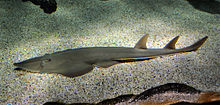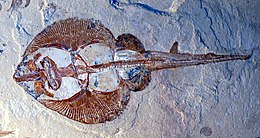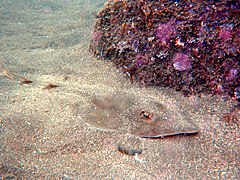| Rhinobatos Temporal range: 150–0 Ma PreꞒ Ꞓ O S D C P T J K Pg N Tithonian to Present | |
|---|---|

| |
| Rhinobatos rhinobatos | |
| Scientific classification | |
| Domain: | Eukaryota |
| Kingdom: | Animalia |
| Phylum: | Chordata |
| Class: | Chondrichthyes |
| Subclass: | Elasmobranchii |
| Order: | Rhinopristiformes |
| Family: | Rhinobatidae |
| Genus: | Rhinobatos H. F. Linck, 1790 |

Rhinobatos is a genus of fish in the Rhinobatidae family. Although previously used to encompass all guitarfishes, it was found to be polyphyletic, and recent authorities have transferred many species included in the genus to Acroteriobatus, Glaucostegus, and Pseudobatos.
Species
The 20 currently recognized species in this genus are:
- Rhinobatos albomaculatus Norman, 1930 (White-spotted guitarfish)
- Rhinobatos annandalei Norman, 1926 (Annandale's guitarfish)
- Rhinobatos austini Ebert & Gon, 2017 (Austin’s guitarfish)
- Rhinobatos borneensis Last, Séret & Naylor, 2016 (Borneo guitarfish)
- Rhinobatos formosensis Norman, 1926 (Taiwan guitarfish)
- Rhinobatos holcorhynchus Norman, 1922 (Slender guitarfish)
- Rhinobatos hynnicephalus J. Richardson, 1846 (Ringstreaked guitarfish)
- Rhinobatos irvinei Norman, 1931 (Spineback guitarfish)
- Rhinobatos jimbaranensis Last, W. T. White & Fahmi, 2006 (Jimbaran shovelnose ray)
- Rhinobatos lionotus Norman, 1926 (Smoothback guitarfish)
- Rhinobatos manai W. T. White, Last & Naylor, 2016 (Papuan guitarfish)
- Rhinobatos nudidorsalis Last, Compagno & Nakaya, 2004 (Bareback shovelnose ray)
- Rhinobatos penggali Last, W. T. White & Fahmi, 2006 (Indonesian shovelnose ray)
- Rhinobatos punctifer Compagno & J. E. Randall, 1987 (Spotted guitarfish)
- Rhinobatos ranongensis Last, Séret & Naylor, 2019 (Ranong guitarfish)
- Rhinobatos rhinobatos Linnaeus, 1758 (Common guitarfish)
- Rhinobatos sainsburyi Last, 2004 (Goldeneye shovelnose ray)
- Rhinobatos schlegelii J. P. Müller & Henle, 1841 (Brown guitarfish)
- Rhinobatos thouiniana (Shaw, 1804) (Shaw's shovelnose guitarfish)
- Rhinobatos whitei Last, Corrigan & Naylor, 2014 (Philippine guitarfish)
Extinct species


Species within this genus include:
- †Rhinobatos bruxelliensis Jaekel 1894
- †Rhinobatos casieri Herman 1975
- †Rhinobatos grandis Davis 1887
- †Rhinobatos hakelensis Capetta 1980
- †Rhinobatos incertus Cappetta 1973
- †Rhinobatos intermedius Davis 1887
- †Rhinobatos latus Davis 1887
- †Rhinobatos maronita Pictet and Humbert 1866
- †Rhinobatos primarmatus Woodward 1889
- †Rhinobatos sahnii Sahni and Mehrotra 1981
- †Rhinobatos steurbauti Cappetta and Nolf 1981
- †Rhinobatos tenuirostris Davis 1887
- †Rhinobatos whitfieldi Hay 1903
†Rhinobatos beurleni Silva Santos 1968 moved into its own genus, Iansan.
Fossil record
These fishes lived from the Tithonian age to Present (from 150 to 0 million years ago). Fossils have been found in Brazil, Europe, Africa, Jordan, Syria, Saudi Arabia, India and United States.
Gallery
See also
References
- Wilga, C.D.; Motta, P.J. (1998). "Feeding mechanism of the Atlantic guitarfish Rhinobatos lentiginosus: Modulation of kinematic and motor activity". Journal of Experimental Biology. 201 (23): 3167–3184. doi:10.1242/jeb.201.23.3167. PMID 9808831.
- ^ Naylor, G.J.P.; Caira, J.N.; Jensen, K.; Rosana, K.A.M.; Straube, N.; Lakner, C. (2012). "Biology of Sharks and Their Relatives". In Carrier, J.C.; Musick, J.A.; Heithaus, M.R. (eds.). Elasmobranch Phylogeny: A Mitochondrial Estimate Based on 595 Species (2 ed.). CRC Press, Boca Raton, Florida. pp. 31–56.
- ^ Peter Last; William White; Marcelo de Carvalho; Bernard Séret; Matthias Stehmann; Gavin Naylor, eds. (2016). Rays of the World. CSIRO. ISBN 9780643109148.
- ^ Last, P.R.; White, W.T.; Fahmi (2006). "Rhinobatos jimbaranensis and R. penggali, two new shovelnose rays (Batoidea: Rhinobatidae) from eastern Indonesia". Cybium. 30 (3): 261–271.
- Last, P.R.; Compagno, L.J.V.; Nakaya, K. (2004). "Rhinobatos nudidorsalis, a new species of shovelnose ray (Batoidea: Rhinobatidae) from the Mascarene Ridge, central Indian Ocean". Ichthyological Research. 51 (2): 153–158. Bibcode:2004IchtR..51..153L. doi:10.1007/s10228-004-0211-0. S2CID 32090559.
- Last, P.R.; Corrigan, S.; Naylor, G. (2014). "Rhinobatos whitei, a new shovelnose ray (Batoidea: Rhinobatidae) from the Philippine Archipelago". Zootaxa. 3872 (1): 31–47. doi:10.11646/zootaxa.3872.1.3. PMID 25544069.
- Paleobiology Database
- Brito, Paulo; Leal, Maria (2013-07-18). "A NEW LOWER CRETACEOUS GUITARFISH (CHONDRICHTHYES, BATOIDEA) FROM THE SANTANA FORMATION, NORTHEASTERN BRAZIL". Boletim do Museu Nacional.
| Taxon identifiers | |
|---|---|
| Rhinobatos | |


